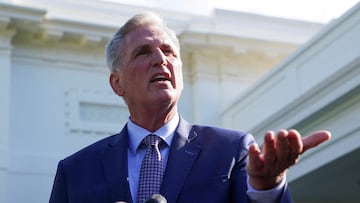How many times has the US raised the debt ceiling?
US Treasury Secretary Janet Yellen warned lawmakers the debt ceiling must be raised once again for the nation to meet its obligations and avoid catastrophe.

The United States Congress is in charge of the nation’s purse strings, and as the decades have gone on, negotiations over spending and debt have become extremely politicized. Currently, the country is two weeks away from defaulting on its debts, which, if allowed to occur would have catastrophic consequences for the global economy.
There was a time when the Legislative branch exercised great control over how much debt was issued, including specifying what instruments and the parameters the Treasury could use to borrow money.
That, however, changed in 1917 as the US geared up to join World War I. The Second Liberty Bond Act provided the Treasury with more flexibility in managing federal finances but set a limit as to how much debt it could take out on the total amount accumulated through different types of borrowing.
Twenty-two years later, as another global conflict loomed, the debt ceiling on nearly all US debt would come into effect. Since then, the amount that the Treasury is allowed to borrow has been raised dozens of times. But in recent years has been used more frequently as a political football.
The brinksmanship behind using the debt ceiling as leverage in budget debates has prompted warnings from the Treasury about their harm to the US economy and confidence in the nation’s promise to repay all debts. Failure to raise the debt ceiling to meet contractual obligations to finance spending bills passed by prior Congresses and signed by both Democratic and Republican presidents would force the US to default on its debt and throw the US and world economy into turmoil.
How many times has the US raised the debt ceiling?
According to the Treasury Department, the US “Congress has acted 78 separate times to permanently raise, temporarily extend or revise the definition of the debt limit” since 1960. The increases have been approved under both Democratic and Republican presidential administrations, 29 times and 49 times, respectively, over that period. This has been the case as both have recognized that it is a necessary measure to avoid “irreparable harm to the US economy, the livelihoods of all Americans, and global financial stability,” in the words of Treasury Secretary Janet Yellen.
The secretary announced that the Treasury Department would have to begin “taking certain extraordinary measures to prevent the United States from defaulting on its obligations” once again. The first time this happened occurred in September 1985 when Congress was at an impasse on how to address the US reaching its debt limit. Three months later, lawmakers agreed to raise the debt limit to $2.1 trillion from $1.9 trillion.
Debt ceiling becomes a political football
More recently, the fight over spending has seen the debt ceiling used as leverage in an attempt to get concessions out of the other party. Famously, Republicans held the debt ceiling hostage in order to negotiate the budget. This forced the Treasury to take extraordinary measures once again to shift funds around to cover the nation’s obligations and avoid defaulting. The episode also led to a government shutdown. Both issues were eventually resolved and the debt ceiling was raised to almost $6 trillion.
Another similar standoff happened in 2011, which led to the first downgrading of the US credit rating by Standard & Poor’s from AAA to AA+. The agency cited the brinksmanship on raising the debt ceiling specifically as the reason for lowering the grade of US debt. The debt limit was raised but two years later the US was once again staring down the “X Date”, the day when the nation would default, as it reached the statutory $16.4 trillion cap on borrowing.
That confrontation over how much the Treasury, and thus the US, could borrow led to another first. Rather than setting a specific numerical increase to the cap, under the No Budget, No Pay Act of 2013, legislators temporarily suspended the debt limit through 18 May 2013. It was then reinstated it at a level accounting for all debt incurred up to that point.
Debt ceiling fights become a regular affair
The gamesmanship has become a nearly annual endeavor with the most recent taking place in 2021. At that time, with the X Date hanging over them, lawmakers in the Senate negotiated a one-time carve-out to the filibuster to end the stalemate. Democrats were allowed to pass a $2.5 trillion increase to debt ceiling raising it to roughly $31.4 trillion.
The US Treasury Department has said that it can make temporary adjustments to extend the period before the country reaches its credit limit. However, after 1 June, there are much fewer actions that can be taken, and Secretary Janet Yellen has urged Congress to pass an increase as soon as possible.
In a letter to Congress sent by the Secretary earlier this year, informing that the department would be taking extraordinary measures once again, Secretary Yellen told Kevin McCarthy, the Speaker of the House: “While Treasury is not currently able to provide an estimate of how long extraordinary measures will enable us to continue to pay the government’s obligations, it is unlikely that cash and extraordinary measures will be exhausted before early June.”






